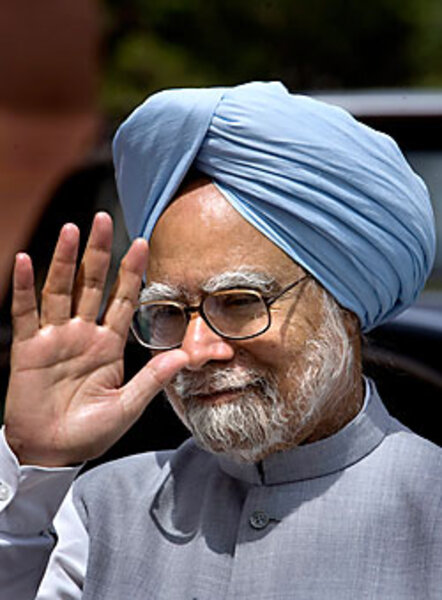In India, a mandate and a test
Loading...
| Mumbai, India
Manmohan Singh, the blue-turbaned prime minister of India, hurried to appoint cabinet ministers from a string of allies shortly after a stunning victory in parliamentary elections in May that defied predictions of a hung parliament.
But as he prepares to shepherd the victorious Congress Party-led United Progressive Alliance (UPA) into its second consecutive term, he faces myriad challenges – from a flailing economy to a tenuous security situation, both at home and in the region.
"My first task is to restore the economy and its growth momentum. There is global recession and we have to protect our growth," Mr. Singh said soon after he was sworn in as prime minister.
Buffeted by the global economic meltdown, the growth of India's gross domestic product has ebbed – to between 6 and 7 percent after a high of 9 percent in 2007. After many years of witnessing rising incomes, the country faces the dour prospect of job losses. The Associated Chambers of Commerce and Industry estimates that this year Indian businesses could lay off nearly 25 percent of their workforce in the areas of information technology, real estate, construction, aviation, and financial services. Close to 40 million middle-class workers are employed in these industries.
Exports fell for the seventh month in a row in April, down a third from the year before. Industrial production has slumped into negative growth.
Pranab Mukherjee, India's new finance minister, announced recently that he would present the government's first budget in July, and promised new allocations for roads, airports, and ports, and reforms in the power sector. "The prime minister has been very clear that the only way to combat recession is to make India an investment destination," he said.
The government 'is broke'?
With its massive victory at the polls, the UPA has amassed the political will – and parliamentary votes – needed to ensure that its agenda can take off. In its previous five years it often could not deliver on many promised economic reforms because of objections from allies like the Communist Party of India-Marxist-led Left Front.
But can India afford such massive spending sprees?
"The government, not to put too fine a point on it, is broke," Abhijit Banerjee, a professor of economics at the Massachusetts Institute of Technology, in Cambridge, and Raghuram Rajan, professor of finance at the University of Chicago, wrote in a recent column in The Indian Express, an English-language daily. "Revenue growth has slowed with the global recession, but the commitments made in the expectation of continuing rapid growth remain with it."
Social-welfare schemes that the UPA launched in its previous term – such as the National Rural Employment Guarantee Act, a landmark antipoverty project that promises every rural family at least 100 days of employment; and an expensive loan waiver scheme for indebted farmers – have burned a huge hole in India's treasury. India's fiscal deficit has swollen to nearly 8 percent of GDP. The fiscal deficit has been deepened by two stimulus packages the UPA announced in its previous term.
But the UPA is popular largely because it splurged on social welfare – it nearly tripled government spending on rural development from $1.13 billion in 2003-04 to $2.87 billion in 2008-09 – and it cannot afford to halt its social spending drive, point out Mr. Bannerjee and Mr. Rajan. More than three-quarters of India's 1.1 billion people, bypassed by the economic boom, survive on less than $2 a day.
"If this election was about anything, it was about hope and trust," they wrote. "People voted for those who they thought were at least trying to deliver something real, and mostly against the kind of shrill populism that promises the moon and delivers little or nothing."
Difficult foreign policy issues
The deteriorating security situation in India's neighborhood – from Pakistan in the northwest to Sri Lanka in the southeast – is of grave concern for the new government.
A May report by the Congressional Research Service, a research wing of the United States Congress, that Pakistan is continuing production of nuclear fissile material for weapons, adding to its stockpile of 60 nuclear warheads, has caused alarm in New Delhi.
India has halted its dialogue process with Pakistan since last November's Mumbai attacks, which it blames on militant groups based in Pakistan. After being sworn in, Singh made it clear that the dialogue process will only resume if "Islamabad takes credible and transparent action against those behind the attacks."
India is also increasingly nervous about China's growing clout in its neighborhood. China is building a set of hydroelectric dams in Burma (Myanmar) and recently beat India in securing a 30-year concession on natural gas from the country's military junta. It is also selling weapons to Pakistan, India's longtime rival, and to Sri Lanka.
"China is fishing in troubled waters," says G. Parthasarthy, a New Delhi-based foreign-policy expert. "This is very worrisome for India."
Air Chief Marshal Fali Homi Major, chief of India's Air Force, in May called China a "bigger threat than Pakistan."
The UPA has begun working on a blueprint to tackle its homegrown terror outfits, which include insurgent groups in the restive northeast, and Maoist rebels, called Naxalites, who are active in 13 of India's 28 states.
"India faces many security challenges both within and without," says Mr. Parthasarathy. "But I am glad there will now be a stable government in New Delhi to handle [these] situations." r





